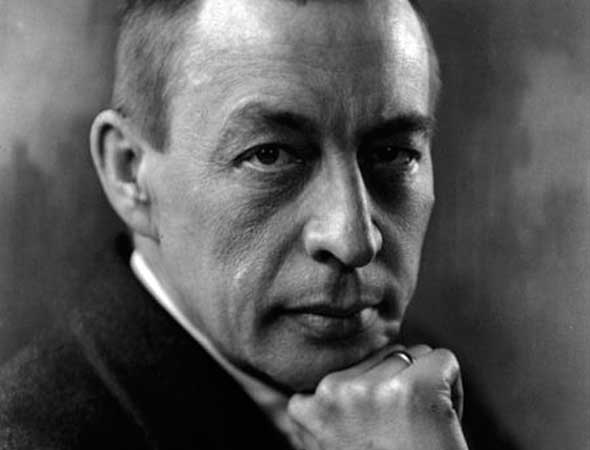RACHMANINOFF – Concerto No. 4 in G minor for Piano and Orchestra, Op. 40

Sergei Rachmaninoff
- Allegro vivace
- Largo
- Allegro vivace
PERFORMANCE TIME: 24 MINUTES
Sergei Rachmaninoff, the last of the great Russian Romantic composers, was also one of history’s great pianists—perhaps among the greatest of all, according to some current re- evaluations of his recordings, piano rolls and performance reviews. With Frédéric Chopin, Franz Liszt, and the great Baroque organists like Bach and Telemann, he was one of classical music’s legendary masters of the keyboard who were also great composers. Of these, he was an heir of Liszt—whose works demand power, speed, and fire— rather than the poetic, introspective Chopin.
If Tchaikovsky was the central and best known of the Russian romantic composers, and if Glinka was the first and the father figure, then Rachmaninoff embodied their artistic culmination. As a conservatory student in Moscow and St. Petersburg, he focused intensively on both piano technique and composition, and he was recognized as a great pianist throughout his career; just before his death, he was touring the U.S. as a piano soloist. Despite his latter-day moodiness and a bit of harmonic adventurism, you can hear that his style was rooted in the 1800s and in Russia as deeply as his predecessors’.
But Glinka and Tchaikovsky remained in the motherland and died there in 1857 and 1893, respectively. Listening to Rachmaninoff’s long, brooding lines—their sweetness tinged with melancholy—it is surprising to learn that he moved to the U.S. and lived in Beverly Hills until his death in 1943. Another Russian expatriate composer, Igor Stravinsky, had come to the United States in 1939, became a naturalized U.S. citizen, and spent time living in Los Angeles. But as a composer, Stravinsky already inhabited a very different, more modern era.
Rachmaninoff’s hallmarks are dazzling virtuosity and plush melody. Big intervals and big sound were natural parts of his musical vocabulary, and seemed to come naturally to his huge hands and long limbs; in fact, it is now believed that he may have had Marfan’s Syndrome, a congenital condition associated with these skeletal proportions, and with heart problems. (Nicolò Paganini may have had it as well.) But if Marfan’s contributed to his heroic sound, there was a more delicate aspect to the Rachmaninoff style—fleet passagework, rhythmic pliancy, and long, singing lines.
It was a long time between compositions for the moody, Rachmaninoff. His mercurial artistic temperament complicated by bouts of depression that almost scuttled his career as a composer; and though he overcame his famous “composer’s block” with the help of friends’ intervention and a physician’s therapy, he remained troubled by his insecurities and by bouts of melancholia. Despite the rapturous reception for his second piano concerto and his standing as a virtuoso, he made the world wait for eight years—until 1909—for his third, and it was not until 1917 that he began the earliest sketches for his Piano Concerto No. 4.
As he would do more than two decades later, Rachmaninoff came to the U.S. in 1918 to regain financial security and a sense of stability. (Born into an aristocratic family, he had lost his assets in the Russian Revolution.) But his initial ideas for a fourth concerto would not be fully developed until 1941, when he introduced the work under the baton of Leopold Stokowski (during another commercial tour of the U.S.).
Considering this beautiful concerto a century after Rachmaninoff first began thinking about it, we can appreciate the artistic paradox he encountered in bringing it to the concert hall. Critics in his own day and in ours called his music Romantic in a way that looked back to his 19th-century forebears. But in this work he shows a new willingness to experiment. In it we can hear contemporary influences such as composer George Gershwin and jazz pianist Art Tatum, an openness to drama and new colors, and less dependence on the sweeping Romantic contours of his earlier works. The slow movement sounds almost like blues; critics cite that as evidence that Rachmaninoff paid close attention to Gershwin’s Rhapsody in Blue. Was this unexpected choice, among others, one reason why Rachmaninoff’s fourth piano concerto was received with less enthusiasm than those that came earlier? Today we appreciate this work not only for Rachmaninoff’s customary brilliance as a composer of virtuosic piano music, but as our best indication of how a “modern” Rachmaninoff style might have sounded.












